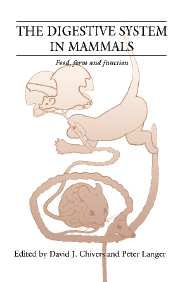Book contents
- Frontmatter
- Contents
- List of contributors
- Preface
- Part I Introduction
- Part II Food
- Part III Form
- Part IV Function
- 18 Foraging and digestion in herbivores
- 19 Gut morphology, body size and digestive performance in rodents
- 20 The integrated processing response in herbivorous small mammals
- 21 Digestive constraints on dietary scope in small and moderately-small mammals: how much do we really understand?
- 22 The effects and costs of allelochemicals for mammalian herbivores: an ecological perspective
- 23 Short-chain fatty acids as a physiological signal from gut microbes
- Part V Synthesis and perspectives
- Index
18 - Foraging and digestion in herbivores
Published online by Cambridge University Press: 18 March 2010
- Frontmatter
- Contents
- List of contributors
- Preface
- Part I Introduction
- Part II Food
- Part III Form
- Part IV Function
- 18 Foraging and digestion in herbivores
- 19 Gut morphology, body size and digestive performance in rodents
- 20 The integrated processing response in herbivorous small mammals
- 21 Digestive constraints on dietary scope in small and moderately-small mammals: how much do we really understand?
- 22 The effects and costs of allelochemicals for mammalian herbivores: an ecological perspective
- 23 Short-chain fatty acids as a physiological signal from gut microbes
- Part V Synthesis and perspectives
- Index
Summary
The foraging decisions of animals determine which food items enter their digestive tracts, but it is the digestive tract that determines net energy and nutrient gain from ingested food. The details of digestive function depend upon the physiological and morphological characteristics of an organism; these vary with the food habits, body size and phylogeny for each species. As a result, the morphology of vertebrate digestive tracts and the processes of digestion and absorption of nutrients are complex (Johnson, 1987; Stevens, 1988). Our purpose here is not to summarize the voluminous literature on these subjects for mammals but rather to address some recent developments in the field.
This section focuses on herbivores because the diets of these mammals often contain low concentrations of digestible energy or other nutrients (usually associated with high fibre content) that has led to great variety in the form and function of their gastro-intestinal tracts. The nutritional constituents of a herbivore's diet vary with the species and part of plant eaten, the habitat in which the plants are growing, and the time of year that the plants are harvested. Because most herbivorous mammals eat a variety of plant species and parts, and most do so year around, they must deal with the problem of variable diet quality. Of course, a few specialists in aseasonal environments may use a limited range of higher quality resources (such as nectar or fruit), but when they do so they lose the advantage of having more available food (stems and leaves).
- Type
- Chapter
- Information
- The Digestive System in MammalsFood Form and Function, pp. 313 - 314Publisher: Cambridge University PressPrint publication year: 1994



